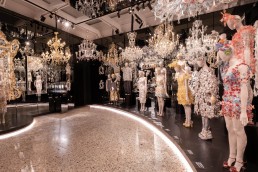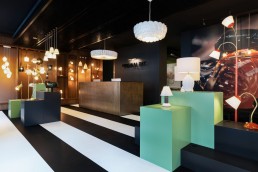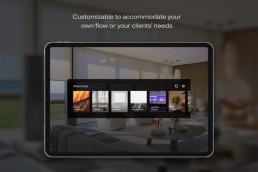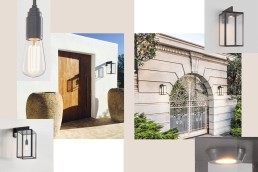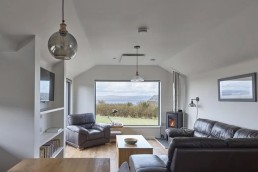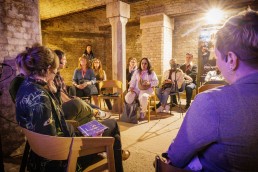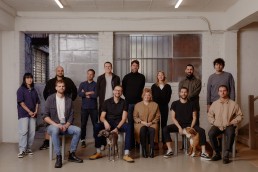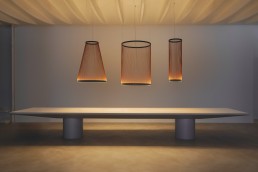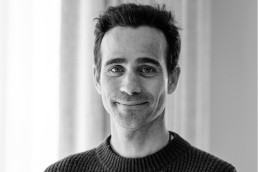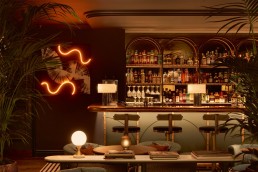Silhouette Awards opens call for mentors
The Silhouette Awards team will review all submissions and contact the successful candidates at the beginning of September 2024, before the new programme begins mid-September.
Those selected will become part of an international network of renowned past and present mentors, defining the winners of the programme by forming a valued part of the judging panel. Mentors will review all nominations and participate in the independent judging process, before being part of the online winner’s ceremony.
Eve Gaut, Silhouette Awards Co-Founder, Parrot PR & Marketing, commented: “As the awards grow each year, it is a wonderful collective achievement to see another 20 young designers’ benefit from the journey with their mentors, progressing their careers and developing the future of the industry. We have seen a lasting impact from the past two years at how the mentorship journey has made a huge difference to our mentees.”
Katia Kolovea, Silhouette Awards Co-Founder, Archifos, added: “As the pool of mentors grows larger and reaches further around the world, we are proud to see how everyone is connecting and supporting each other. It is inspiring to see how our passionate mentors want to continue to benefit the industry. This year’s winners equal 60 young talents so far which have been nurtured, making a massive impact on the future of the industry.”
Applications are open now until 5 August 2024.
Dolce&Gabana partner with Barovier&Toso to light latest exhibition
(Italy) – Barovier&Toso has been chosen by Dolce&Gabbana as the lighting partner for exhibition ‘Heart to the Hands: Dolce&Gabbana’ in Milan, which runs until 31 July.
Bavorier&Toso leased 17 pieces to decorate the exhibition at Palazzo Reale, including chandeliers and suspensions, primarily featuring products from Murano, known for its strong decorative character and gold details.
Among these products is the 4607, a grand chandelier characterised by multicoloured flowers; the Agadir chandelier, inspired by Morocco’s Atlantic coast with its spiral workmanship; a crystal and gold Venezia 1295 chandelier, and the iconic Taif chandelier designed by Angelo Barovier in a 12-light and half-chandelier version. Additionally, six gold-coloured Robin suspensions were chosen to light the exhibition area dedicated to the tailoring workshop.
The invitation for Barovier&Toso to partner came from a longstanding relationship between the two ‘Made in Italy’ brands, including its significant collaboration on the Dolce&Gabana Casa Collection in 2021.
www.barovierandtoso.com
Original BTC Expands Global Presence with Munich Showroom Opening
(Germany) - British lighting manufacturer Original BTC has expanded its presence into Germany with a 1300sqft showroom designed by interior designer, Sebastian Zenkner.
The brand has expanded its global footprint over the past few years, with the opening of the Munich showroom marking its sixth location. The new showroom, located at Gärtnerplatz 1, 80469, Munich, combines modern interior design with classic elements and plays with contrasts, similar to Original BTC’s lighting fixtures. Its aesthetic is reflected throughout the showroom. Both the products and interior design emphasise the importance of craftsmanship and high-quality materials.
Lutron Expands Launch of New Immersive Luxury App to EMEA & Asia
(UK) – Lutron Electronics ‘Luxury Experience App’, which brings the showroom to the customer, is expanding to Europe, Middle East, India and Asia.
The Lutron App enables users to take an immersive look at the Lutron portfolio from lighting, blinds and controls and visualise how it would look in the user’s home – effectively bringing the showroom to the customer.
The app’s camera allows users to visualise products in any space, offering features like the ‘shades openness simulator’ to visualise window blind fabrics and openness factors, ensuring the selected fabric to measure the balance of outdoor views, light filtering, and privacy. Additionally, a keypad configurator allows users to customise and preview keypads designs tailored to user’s preference.
Michael Smith, Vice President and International Sales manager at Lutron, says: “The new Lutron Luxury Experience App has completely revolutionised our ability to communicate the impact of lighting, blinds, and controls to our users. But its power goes even further by giving customers the ability to personalise options to their style and visualise how those options might look in their own home. The app sets a new standard in the industry, and we’re thrilled to expand its availability to over 100 additional countries around the world.”
The app is now available on iPadOS 14 in UK, Middle East, Europe, India and Asia.
You can find Lutron’s Luxury Experience App here.
Ilford Wall Range - Tekna Lighting
Discover the meaning of lighting where innovation and elegance meet. After many years of our classic Ilford Wall range, we decided to add an updated fixture. The Ilford Wall LED is our newest addition that integrates enhanced LED technology for superior performance. With 1000 lumens, it illuminates spaces like never before, adding a sleek element towards our already authentic feel. Experience the perfect blend of functionality and elegance with Tekna.
Industville release exclusive launch with John Lewis
(UK) - The sustainable hand-crafted lighting and décor company has released an exclusive range of products with British retailer John Lewis.
Its partnership signals an expansion in Industville’s retail presence.
Launched on 26 June, the selection of 27 products and designs are now available on the John Lewis website. The edit includes decorative and function pieces including wall fixtures, pendants and table lamps.
Mara Rypacek, Founder of Industville, says; “We are incredibly proud to partner with John Lewis. Their reputation for excellence and commitment to quality aligns perfectly with or core values and together we look forward to illuminating homes across the nation with our design-led, handcrafted lighting. The collaboration is already off to an exciting start with orders rolling in and we’re excited to see what the future holds.”
www.industville.com
:
[d]arc media host networking events at CDW
(UK) – [d]arc media announce two events as part of its [d]arc thoughts talks programme at Clerkenwell Design Week (CDW) providing a insights and inspiration from the lighting industry from 21 – 23 May.
On Wednesday 22 May from 17:00 onwards – CDW visitors are welcomed to join the [d]arc media team to enjoy refreshments and network with like-minded designers. The informal drinks, held at the Light House of Detention, will follow the ILP’s ‘How to be Brilliant’ talk at 16:00, which sees designers Melissa Byers, Abbie Hill, and Anna Freiesleben of Michael Grubb Studio take the stage.
The following day, [d]arc media is teaming up with Women in Lighting to co-host a networking brunch as part of the Design Meets programme, under the title ‘Women’s groups and why do we need them?’. Taking stage 11:00 to outline objectives for 2024 include Carmella Dagnello, Ridge and Partners (Women in Lighting); Harsha Kotak, Women in Office Design Network; Kimberly Bartlett, Introba (Women Lighting Professionals); Rachael Davidson, Hut Architecture (Women in Architecture); Zoe Bronser, Women in Furniture network.
Alongside these networking opportunities, the [d]arc thoughts programme will take centre stage at the House of Detention, Clerkenwell providing insight and education on lighting design. Topics include statement lighting; quiet luxury; and the future of hospitality design. [d]arc thoughts will also see the GreenLight Alliance take a closer look at sustainable lighting.
A full look at the full programme can be found at: www.clerkenwelldesignweek.com/darc-thoughts
Both networking events and talks are free to attend for visitors registered for Clerkenwell Design Week: www.clerkenwelldesignweek.com/register
Vaulker Haug Studio
Volker Haug, a German-born product designer based in Australia, shares insights into his journey from being a hairdresser to becoming a renowned creator of industrial and sculptural lighting over the past two decades.
Volker Haug, originally from Germany, is an Australian-based product designer that has been creating industrial, sculptural lights for the last 20 years. Unexpectedly, Haug reveals that his first career began as a hairdresser. This avenue led him out of his hometown Stuttgart to Berlin and then to London, UK. “I remember having lived in London for three and a half years I wanted to move on. I couldn’t see myself growing old there,” he tells darc. “I met a lot of Australians that reside in London. So, I thought I would travel to Thailand and then to Australia to see some of these friends. Which I did, and never left!
“I remember arriving in Sydney in 2000 and I fell in love with Australia straight away. I was so happy to be there. I was in Sydney for about three months and tried to make a living there. It didn’t quite fall into a place, so I thought I’d go down to Melbourne after some friends told me I’d love it. I arrived in August, so it was winter, it was raining all the time, but things fell into place for me pretty quickly and I ended up staying. I got my residency through Australia’s skilled migration system as hairdressing was on the list.
“Why Australia? For some reason I wanted to get as far away from Germany as I could. I think I managed it! Living somewhere else and being independent has always excited and interested me.” Having put roots down in Melbourne, Haug worked as a hairdresser for five and a half years. But lighting, and the idea of creating it, was always in the back of his mind.
“Lighting was something that I had wanted to do all my life. When I was young, I was always playing with lights and switches to the point my parents had to tape them down. When I was about 10-years-old, I started making my first lighting range in a wood workshop in the Czech Republic. It was a ceiling scone, two wall lights, and some track lighting for the kitchen. I still remember those lights very well. They were actually pretty cool, obviously very different to my designs now, but it definitely sparked something in me. “Throughout my whole hairdressing career, I always tinkered with lights. In fact, I made lights for the salons I worked in, and some of my hairdressing clients went on to become my lighting clients. I came to realise that hairdressing was not my real passion. I love it and did it for almost 20 years but I couldn’t stop thinking about lighting.”
The challenge for Haug then came with figuring out how to get into the product design industry. “It’s not a job that you find in the yellow pages. These days it’s a bit different, but back then it was not as easy. Through my good industry friend Christopher Boots, I ended up meeting an amazing lighting designer, Geoffrey Mance, who has now passed unfortunately.
“Chris and I lived together for a while. He met Geoffrey at a university talk, where Geoffrey invited everyone to his studio – being as friendly as he was – so off we went and hours later we both returned with a job, which was amazing. We were working on these twig ball lights made from Hawthorne heads with lots of thorns in it. It was a very sculptural piece and really interesting to work on.
“Working with Geoffrey opened a whole new door for me. There was a lot of magic in the way he perceived lighting design, and he was very playful with it. It was an incredible realisation for me to see that you can actually make a living doing it. It was like fulfilling a dream. Yes, money is something we all need to make, but the chance to fulfil a dream comes first, and he showed me how to do that. He helped me breakthrough into the industry.
“We worked together for about a year and a half, during which I learned a lot of things; I also learned how not to do many things. But I am forever grateful for that experience. About another 18-months after that point that I decided to start on my own.”
And that was exactly what Haug did. In his garage. For a couple of years, he was creating lighting pieces during the day and cutting hair in his spare room at night. He then decided to take the plunge and expand into a 20sqm studio. “The garage was running out of space, and I just needed to separate where I was living to where I was working. It worked well for a time, but you have to be careful that you don’t slip into a place of constant tinkering.
“I remember moving into the new workspace, and thinking ‘Jesus, this place is really big, how am I going to fill it?’, 11 months later I had to move because I needed more room.”
Haug’s second studio was located at an old convent in Abbotsford, which are being converted into artists’ studios as and when they receive funding. The 200sqm studio again seemed like a daunting place for Haug to grow his business and collections.
“The studio had two rooms and part of it had a glass floor, which they told me was indestructible. I managed to break the glass floor…Twice. So, I guess I proved them wrong! I was mortified. Don’t ever move into a studio with a glass floor if there are heavy tools involved!”
After a little over a year, Haug had to pack up and move on to a bigger space. It was at this point that he changed from a sole trader to a company and had two official employees at the studio. Prior to that, he was hiring friends for AUS$10 an hour to help out.
As the brand began to grow, the team of now 20 including Haug, went on to settle in their fourth and current location at Brunswick East where Haug has been designing and creating for the past 12 years. “It’s a beautiful old 1940s warehouse that used to be owned by Worths Hosiery, which was the first to introduce pantyhose to the Australian market. When we first moved in, we actually found some leg mannequins still there, which we made into flower vases!”
Returning to the topic of Haug designing his first “lighting collection” at the young age of 10, he explains how his family were creative but in the musical sense, and perhaps weren’t a direct influence on his interest in interiors and product design. “I was made to play instruments, but never had an interest in it. None of my family had worked in design or ran their own business and it took them a while to get their heads around the fact that that’s what I was doing and are now very happy for me.”
When discussing influential elements in his life now as an established designer, Haug references the world he sees around him as a constant source. A key figure in the design world he has always admired is the late Ingo Maurer, whom Haug was lucky enough to meet a couple of times before he passed in 2019.
“I remember going to Milan around 2010 with a bag of lights on a mission to meet Maurer, and to see what Milan Design Week was all about. Maurer gave me some really great feedback and inspired me to take things further. For example, I had a light fitting made from plastic adapters, which he liked the look of but thought if I was to change the material into something more sophisticated and increase the size, it would potentially be a great thing. I ended up exploring that idea and doing exactly as he suggested. I made the fixture out of ceramic porcelain and blew them up in size, which meant they became a very different product. The other thing I learned from him and all his books (I’ve read them all) is to keep going and never stop.”
A significant moment for Haug in his career was when his designing ventures came full circle, and he was exhibiting at Milan the same year as Maurer. “That was an incredible moment when I realised, I am in this same world as him. It made me very happy.”
Another notable marker for Haug was working with the National Gallery in Melbourne when it acquired an OMG chandelier. It’s made out of aluminium light shades crushed into a really flat pizza base shape and then anodised in beautiful iridescent colours, then bolted together into one big shade. So, roughly 20 crushed old factory lightshades have become one new big light shade. The space the gallery had was so big we had to create a larger version that was roughly 2.1-metres in the end. “This installation really means a lot to me. The light, which is still hanging there today, really sums me up, as it’s brutal and crazy, but beautiful. Well, I’m not brutal, just the industrial aesthetic.”
These chandeliers were also commissioned by Westfield shopping centre back when Haug was first starting out. “I remember where I was standing when the lady called me, and that’s when my whole future changed. Westfield, being huge, needed 65 shades. It was then I had to stop cutting hair. I already knew that point was coming soon, but this cemented that moment. I remember the day I finished, I just cried because it was so overwhelming. It was bloody scary.
“We still do some shopping centre projects alongside our more luxury clients. But I am forever grateful for the shopping projects. Westfield was one of the instigators to me quitting my hairdressing job and got me into gear to become a lighting business. And the shades are still there today. Reflecting on this, I am also very grateful to Australia, as the country provided me with real opportunity. I sometimes wonder if the same would have been if I had stayed in Germany.”
Haug’s studio is currently formed of 19 international and local employees. Each coming from various industries and backgrounds, which has enabled Haug to create a design team that brings something unique to the table, yet in line with his vision. “We make such a good team as we all have a say. I really value everyone’s opinion. Everyone has a different role in our business, and everyone is important. I’m very grateful for their amazing loyalty; many of them have been with me for many years and it’s just crazy.”
Industrialism is a constant aesthetic theme that can be seen in Haug’s work since the beginning. He likens this to his personal taste as well as being influenced by the materials that were available to him at the time. “We have explored many different materials and ways to use them over the years. Anything from glass, which we’ve only introduced in the last five years or so, to brass which I have always worked with and pushed to its limits. That’s where many of our industrial designers come in - they have such a knowledge about materials and how and what you can use them for, it’s incredible.
“Another thing we do, which is always well-received, is not hide the materials in our products. We may polish them, for example, or seal or patina them, but you can always tell what is underneath. And with the casting, you can feel the roughness and unevenness, which adds to its beauty.”
When asked what qualities a good light should have, Haug explains that it’s always a good balance between beauty and functionality. He also believes they should be built to last a long time. To aid this, his studio provides a service for repairs and cosmetic touch-ups to ensure clients’ can keep the piece in situ for as long as possible. Not only does this allow the lights to be passed down generations, but it is also a positive approach to sustainable product design, to discourage waste.
Reflecting on his two decades as a designer and manufacturer, Haug describes the most frustrating and most rewarding aspects: “I think probably the most frustrating thing about design is if you are being copied by other people. Sometimes it can be ruthless. I never thought it would happen to us, but it has. I’m glad to say it’s not as often as other designers, but there are particular ranges that have been copied. “When I see our lights on eBay for a 10th of the price, but also 10th of the quality, it’s very sad.
“Another thing that I find difficult is the fact they can ruin your reputation. We have been contacted in the past by people claiming they have a crooked light, or it doesn’t work. So, we ask them to send over photos to discover it’s not an original lamp, but a copy. It can ruin your name.
“Some still say it’s a flattering compliment, and we do what we can to help mitigate it. We make a racket to those that are copying, tell them we know they are doing it and ask them to stop, and that’s pretty much all we can do.”
Continuing on this moment of reflection, Haug looks back on how his studio has changed over the last 20 years, as well as his personal development: “It happened gradually. Of course, there were moments where things grew really quickly and other times slower. I remember there were certain growth bursts, which were frightening but also incredible. When they happen, it can be daunting; I would need to employ another two or three people at once. You employ them for a reason, and if it works and makes your life easier, then it’s obviously the right decision. Stick to trusting your gut and see what works.
“On a personal level, I don’t how I’m juggling it all, but you just sort of do. I guess it’s all happened gradually, and you just learn as you go. You must listen to what’s going on and what people have to say, what people’s needs are, but also people have to listen to you. Having regular meetings and involving people is really important. Together, we can do more.
“I think I’ve become a fairly natural leader. I haven’t done many leadership courses - I need to do more - but I just go with my gut. Sometimes I have success, and sometimes I want to hit my head against the brick wall! But then, I have been told by some that I have been the best boss. What can I say? That’s what I really want to achieve, and if that is being affirmed then it’s a beautiful thing.
“From a design perspective I have changed the way I approach things a lot. I have worked alongside many professional industrial and interior designers as well as jewellers.
“I look at things very differently, much more critically and through a different pair of eyes. Also, more practically. Before it was like, ‘Oh, I love this, I want to design it’. And now it’s more like, ‘Okay, we want to design something that is a bit more restrained’, but restraints are there for good reasons such as what does the market need? If it’s a wall light, how much should it cost to fit a particular brief? Or what size does it need to be to fit the American market? These are things I’d never thought about before.”
The conversation turned to discussing current product trends and aesthetics. He explains that as a studio, they typically like to visit different eras and take inspiration from some of the best that era has to offer. “At the moment, the 1970s is definitely coming through. I still have the industrial boldness to it, which is really beautiful, along with brutalist elements. We like to reference certain times and the way things were done but bring that to the current day with today’s technology.”
During Milan Design Week 2024, Volker Haug debuted Me and You, a lighting collaboration with Australian multidisciplinary architectural designers Flack Studio.
During a Flack Studio project instal, a vintage glass wall sconce was irreparably broken. With the back plate already in place, Flack called on Haug to urgently design a new, site-specific fitting. Fuelled by simpatico and shared aesthetic sensibilities, a long history of friendship, and neighbourly proximity, the rapid-fire nature of ideating, prototyping, and editing was an experience of total cohesion. The error that instigated the collaboration ultimately produced a playful and friendly design journey.
The collection expresses a shared studio vernacular, and the functional symbiosis of interior and industrial design disciplines. Flack’s design discernment came from envisioning each light’s presence in-situ within the space; whereas Haug would see a light from all the same angles, only to push technical and material features even further.
As the name suggests, Me and You speaks to the collaboration, but also to the inherent interplay of light and space — a relationship that the two studios believe is the most important decision of the design process.
Eschewing the prescriptive idea of building a collection with strict features scaled across different, singular light forms, they favoured an unrestrained approach. Through lines of instinctual familiarity, from repetition to material to colour, yielding a satisfying series of diverse styles, proportions, materials, and detailing. Foundational to the collection is a set of interchangeable wall sconces—differentiated by their varying luminosities—that are intended to be installed as individual lights, sets of pairs, or as a series. Dualities of ‘soft’ and ‘hard’ echo throughout. In contrast to mouth blown glass elements and features like rotund metal cages, there was also opportunity to apply material refinements to some of Flack Studio’s more angular earlier designs.
Iterations of their original lighting for Ace Hotel Sydney—think grid-like characteristics and linear silhouettes—came to life alongside another of the new collection’s stand-out lights: Troye. The re-envisioned sconce found its inspiration in a custom lamp designed by Flack Studio for actor and musician Troye Sivan’s Melbourne home. Its edgy metal exterior hugs a hidden light source, with punchy perforations to reveal its glow.
The collection represents Flack and Volker Haug’s shared belief in the truth of materials, and their innate ability to speak for their own beauty and radiance. With this ethos in mind, the lighting is designed in a consciously limited range of brass, aluminium, glass, and fibreglass.
“It was such a pleasure working with Dave and his team from Flack. It’s just been a beautiful, easy, and fun collaboration. And, one of the most rewarding things is when the doors opened for our exhibition in Milan, people came in and they loved it. That’s when I think, ‘Wow, we’ve nailed it.’”
Materials - Vibia
This year’s winner of the decorative lighting product at the [d]arc awards was Vibia’s Array collection designed by Umut Yamac, who’s studio is characterised by a multidisciplinary approach that explores the middle ground between architecture and light.
Composed of an array of fine threads pulled taut between two aluminium rings, the collection presents a variety of elegant conical and cylindrical silhouettes that shimmer enticingly overhead, evoking a sense of refinement that can be enjoyed in any context.
Yamac speaks with darc about his design inspirations and concept for the award-winning collection.
“The idea for Array evolved over a number of years, and through various projects and prototypes. Originally, we were really interested in transforming a humble material – thread – and using repetition, tension, and space to trace spatial forms,” he explains.
“We were fascinated by the question of how little material do you need to define a volume? How can this form occupy a space without taking over it?
“The voids between the weave create a sense of transparency that means you can go quite large without feeling obtrusive. Instead, these volumes explore, reach out into the space, let the air pass through and become a liminal architectural element. With Array, we are suggesting a form without completing it, instead letting the viewer complete it in their mind’s eye.
“There were many technical challenges that related to working with thread in such a precise way. For me, the joy and beauty of the product comes from the precision of the thread and its tension and spacing, so this was a key area that required extensive research and development.
“As thread has not been used in this way before, we had to look to other industries for potential collaborators and solutions. Thanks to the commitment and work of the product development team at Vibia, the solution came from the fashion industry and a partner within the knitting industry.”
Expanding on his collaboration, Yamac adds: “The collaboration with Vibia was very natural, intuitive, and enjoyable. From the outset we had a shared vision for the potential of the collection and what could be possible working with thread in a spatial way.
“Vibia bring a wealth of experience in craft, product development and industrial processes. Also, a curious and a very collaborative approach. I think we also bring a playful curiosity and an artistic mindset with an architectural understanding.”
The Array collection incorporates various shapes and sizes, the largest of which extends to nearly two metres in height and 124 cm in diameter.
Array’s impressive scale by no means limits its use to public and commercial settings. The collection includes various smaller models suitable for residential use, the shortest of which stands at a modest 73 cm in height.
When it comes to mood, Array is as dynamic as it is intimate. The layering effect of the threads creates the illusion of movement with the shifting gaze of the viewer. In a restaurant setting, this effect is both subtle and spectacular. A series of identical cylindrical fixtures can be used to flood a long dining table with brilliant, dynamic light.
Alternatively, multiple pendants can be suspended low over individual tables, their lightweight form creating an air of romanticism that amplifies the space they inhabit.
In terms of palette, Array’s matte black rings are complemented by a choice of terracotta red, sober green, or soft beige threads.
These natural tones lend an earthy richness to a minimalist interior, particularly as they interact with the light as it washes up from below in a gradient of colour.
Beatle Lindsay-Fynn
Founding Partner and Managing Director of Palladian, a London-based architecture and interior design practice, gives his opinion on maximising wellbeing in residential lighting.
Wellbeing has been a key driver right across design for a number of years and probably nowhere more so than in the workplace, where employers met the challenges of Covid-19 and post-pandemic hybrid working by evolving worker-first interiors, complete with breakouts, garden centre levels of planting, quiet rooms and ultra-flexible, mission-oriented environments. In the residential sphere, however, where we operate, wellbeing can often be taken for granted. It’s as if the home, representing ‘the authentic self’, is a pre-designated locus for refuge and relaxation and therefore self-evidently a place where we feel ‘well’.
We oppose this passive attitude for many reasons, but not least because home interiors are something of a wellbeing battleground right now. Many recent advances in home technology - particularly wireless and Bluetooth - generate electromagnetic frequencies, which are absolutely not conducive to wellbeing. Equally, many sustainable advances, including triple-glazed, energy-saving windows, are in danger of having a negative impact too, by cutting out the sun’s most energy-giving lightwaves, especially in the morning. Then, there’s the flickering problem with many low-energy sustainable lamps, especially cheap LEDs and fluorescents. Even if our eyes can’t see the flickers, our brains can, and the repeated pulsing can have a woeful impact on our nervous systems. Electronic drivers and dimming modules in the home need to be carefully monitored for the same reason. Having a house hard-wired with on/off switches or using a hard-wired control system - as long as properly evaluated - can be a better wellbeing solution, however much against the contemporary grain.
Ensuring our homes have enough light of both the right temperature and lux/intensity levels, while prioritising health, sustainability, and people’s technological needs, is a complex ambition, necessitating informed strategies and careful thinking to find a pathway through.
At the start of a residential renovation or new interior design project, lighting designers are usually briefed to design a scheme with specifications that meet a particular budget or aesthetic, while providing appropriate washes, colours, and levels of light and taking into consideration a home’s architectural or interiors layout. Clients without lighting designers are often simply trying to generate enough artificial light within a budget, with less consideration of other factors. In both instances, the wellbeing of a home’s occupants may be of lesser consideration - if considered at all.
A home is many things, from a social space to a quiet space and a place for eating, working, and playing. Most importantly, home is where we sleep - a vital restorative action for our bodies, minds and souls. A wellbeing-first residential lighting scheme needs to take on board home-owners’ personality types, neurodiversity typology, any health issues and particular personal circumstances alongside the design brief, budget and current lighting product availability. The ideal end result is a series of personalised lighting solutions for each family or occupier’s requirements, in much the same way people currently seek out personalised healthcare, nutrition or exercise programmes.
Light will always be the single most important element within the built environment, fundamentally driving the rhythm of life. Lighting design needs to prepare our bodies for sleep and wake us in the morning, working directly with our circadian rhythm. Regulating our exposure to different light sources throughout the day is key to promoting our overall mental and physical health and performance.
Artificial light remains a great gift, particularly for those living in darker, North European climates, enabling increased functional and leisure time over the course of a day, but the season, the orientation of each building and even each room’s geometry all have to be considered, in line with the natural course of daylight, when assessing artificial lighting needs. You might organise your bedrooms to be facing east, for example, or your living spaces to face south and west, while, to provide the best level of daylighting, the visible light transmittance of glazing should be high, with windows kept open as much as possible to absorb full spectrum light. Solar heat gain should be considered and kept low over the summer too, however, making rooflights something of a pay-off between additional light ingress and solar gain implications.
Those with a higher budget can choose lighting control systems based on astronomical clocks, linked to light sources that change temperature in accordance with natural light, but the principles for lower budgets are the same. Residential lighting basically needs to incorporate thought-out layering, featuring different light source typologies, including white task lighting above head level to mimic the rising sun - though the latter should only be viable from a biophilic perspective for a short period. Lighting should then mirror the move to warm white and finally amber hues as the day goes on, via wall and floor lights, reflecting both the colour and the position of the sun.
We also need to be wary of lighting that looks yellow but is in fact white, as is often the case with LEDs, while overhead grids should be avoided, full-stop. It’s certainly worth spending money on the highest-possible quality LEDS, while anyone exposed to too much blue light via laptops, tablets and phones in the bedroom would do well either to change habits or counter the subsequent block to their melatonin levels, causing a reduction in sleep quality, by investing in special blue-light-blocking glasses.
Once the optics of how these elements are approached during the design stages are aligned with the occupier’s wellbeing, any contradictions with technology and sustainability are by no means insurmountable and can create an enjoyable journey whose outcomes profoundly impact a home’s inhabitants. Further technological advances should continue to be assessed from a wellbeing perspective, so that the key role lighting plays in protecting our wellbeing at home – exactly where we need it most – is always recognised, prioritised and enabled.
Paola Navone
During Milan Design Week, Italian lighting brand Lodes presented Oblò, a collection of glass pendants designed by Paola Navone that take inspiration from the seaside.
Lodes’ latest collection, Oblò, is the inaugural collaboration with Otto Studio’s Paola Navone. Oblò presents an aesthetic departure from Lodes’ existing portfolio; it is both a high-performance pendant and a sculptural piece of design that presents themes of fluidity and water.
“Oblò is a delightful family of lamps that touches on the essence of the sea,” says Navone. “The glass diffuser, with its soft, rounded shapes, is suspended by a knotted cable, appearing to float in the air like a buoy. There’s a touch of surprise: the knotted cable houses an invisible LED source that illuminates the diffuser. Thus, only the glass is visible, akin to peering through a porthole. The diffuser comes in three different shapes and five finishes, three of which are hues reminiscent of the sea’s transparency. Where a single lamp serves as a playful focal point, a multitude of lamps make up a thousand different installations.
“Water is my natural element, the sea has a relaxing, almost hypnotic effect on me. It stirs feelings of delight, peace, fluidity, movement... and it always makes me wonder how to connect these elements within design.”
Oblò is a modest sized lamp that comes in three sizes and with an intense luminosity, which is diffused through the glass globe that is available in various finishes including: Silk White, Clear, Glossy Smoke, Iridescent, Azure Steel.
It features a hook, comprising a metal core coated with semi-transparent silicone. A white fabric cable, featuring a grey rubberised terminal, is tied to the hook, delicately supporting the diffuser. The knot and cable possess both aesthetic and functional significance: envisioned by the designer to resemble naval ropes knotted to sea buoys, infusing the product with a whimsical and playful spirit. Simultaneously, the fabric cable conceals the electric wiring, which, through the knot, threads into the hook, discreetly powering the LED. This gives the appearance of the Oblò floating like a buoy in the air.
Speaking of her collaboration with Lodes, Navone says: “There is a special alchemy behind each of our projects at Otto. It can come from meeting a person, a company, discovering a place or a beautiful tradition. This time we were enchanted and inspired by Lodes’ technical expertise and high-quality materials.
“We enjoyed recalling the simple, friendly, and universal shapes of buoys. Lodes’ expertise and technology made it possible to realise these forms using Pyrex, a highly evocative material, that was modelled and formed into soft, rounded shapes.
“The idea was to create a weightless, almost imperceptible bubble and the main challenge was to make the light source invisible. Using Lodes’ know how, we developed a hidden LED source inside the hook that lights the glass diffuser.
“The diffuser comes in three different shapes and five finishes - demonstrating the versatility of Pyrex glass in lighting design while simultaneously evoking images of the sea and the elements that float in the water. Additionally, the fabric cable conceals the electric wiring, which, through the knot, threads into the hook, mysteriously powering the LED.
“We really like the knotted cable that supports the lamp like a naval rope tied to a sea buoy, and at the same time powers the LED source that lights up the diffuser. It adds that element of surprise that is always present in our designs.”
Reflecting on the new collaboration, Lodes Managing Director Massimiliano Tosetto comments: “We are thrilled to collaborate with Paola Navone – Otto Studio on this new lamp, furthering Lodes’ portfolio to seamlessly integrate with a wide range of environments. The flexibility inherent in Oblò, in terms of compositions and finishes, was vividly articulated by the designer through a stunning colourful installation during Milan Design Week, hosted at Lodes’ Milan showroom.”
www.otto.fish
www.lodes.com
Copper Club
Renowned for its edgy interiors and creative branding, Run For the Hills studio, has transformed a cherished local landmark in Guildford, UK into a lavish three-floor multi-faceted club house. darc talks to co-founder and interior designer of Run For the Hills, Anna Burles, as she offers insights on the design and the necessity of decorative lighting.
The collaboration between Run For the Hills and Copper Club began after the client stumbled upon some of studio’s portfolio in a magazine. Recognising the studio’s unparalleled fusion of interior and graphic planning offered everything the client needed from interior planning, bespoke art designs, and unique branding to boot. From there the brief was clear - to create a guest-experience with technical design, operational pointers, and detailed brand storytelling.
Located on the cobbled streets in Guildford’s high street this beloved building was once a tailor’s shop known as Burton’s. Now the building is open for locals to use, offering a member’s club mentality where guests can settle all day for work and play but without membership fees and exclusivity. It features expansive crittal style windows framed with a soft blue façade and hand painted gold signage inspired by its former life as Burton’s tailors.
The client was a huge fan of heritage features and its history as a popular tailor shop; hence the new logo displays a tape measure wrapped elegantly around fabric scissors. However, the building’s most recent incarnation as a sport retailer meant most of these architectural details had been ripped out. Despite its unfortunate dismantle of the original features, this gave Run For the Hills a complete blank canvas to work with. Restoring the heritage features were predictably difficult yet crucial to the design scheme, some of which included coverings and moldings, a statement staircase and a glass lift bringing a sense of its history outside and in.
Like any interior design, decorative lighting has a vital role in creating an essential atmosphere. With The Townhouse spanning across three floors and four zones of function (dining, drinking, working, and socialising), lighting is key to creating a seamless transition between each zone and has a quintessential role in enhancing the ambience with both its stunning appearance and ways of distributing light. Burles says: “Decorative lighting is incredibly important in all of our interior design projects and The Townhouse was no different. Even with the most amazing FF&E furnishing scheme and materials palette, a space feels naked without decorative lighting. Beautiful wall lights, mood enhancing table lamps (both wired and portable), and statement floor lights not only look stunning, but fulfil an essential role in creating atmosphere. A scheme isn’t complete without exciting decorative lighting and getting the balance right between architectural and decorative is key to the best interiors. Too much architectural lighting can feel clinical and too technical and guests can ‘feel’ the fittings and dominance. Not enough architectural lighting can be disappointing too as decorative lighting alone can’t create some of the effects needed to highlight beautiful finishes, furnishings, and joineries. The two really are co-dependent.”
Burles adds: “Our decorative lighting choices were designed to enhance the overall style of the space, using a suite of different-sized wall lights in antique brass, bronze, and iron finishes, some featuring glass, others woven shades. Lots of the fittings feature prismatic and reeded glass details, which create a lovely atmospheric glow and reflections around the fitting. Other choices have very targeted light where the light source is not visible, designed to do a different job of drawing the eye to the object the light fitting is highlighting (whether that’s a piece of art or highlight furniture). Overall, it is a curated mix of creatively sourced lights, from a mix of retailers we know and love, including some lovely vintage fittings from Pure White Lines, Murano chandeliers and Italian style Murano wall lights injecting a shot of glamour and sparkle.”
The ground floor represents a classic Coppa Club design with a vintage inspired timber cafe-bar and a laid-back cosy workspace, in a relaxed and stylish interior. Tonal textured walls layered with curated gallery art are illuminated by E2 Contract Lighting’s bronze picture lights, which set the scene on the ground floor for a fresh and inviting all day atmosphere. Designed to combine the best elements of both a workspace and a café/bar, lighting needs to ensure guests are comfortable whatever their needs. The rear ‘snug’ lounge isn’t flooded in natural light, so is lit softly by floor lamps and architectural lighting to spotlight the soft seating where guests can listen to the crackle of the fireplace. The lighting from low level table lamps and architectural lighting creates a natural flow between café-bar and workspace.
The journey continues in the brass framed elevator that gently transcends past the hand painted mural designed by Run For the Hills graphics and art team. The mural flows and changes from the ground floor’s neutral tones to a deeper and more lively mix of blue accents atmospherically lit with soft pink Murano wall lights by Pure White Lines acting as guides to the middle floor.
Now in the brasserie, the private dining space offers a homely and relaxed feeling for an all-day dining experience serving breakfast to late night dinners. Furnishings such as open banquette seating with contrasting rugs are highlighted by a central antique style chandelier also by Pure White Lines. Wall lights from E2 Contract Lighting add warm rays of light along with more bronze picture lights spotlighting the curated gallery art. The central stone fireplace is framed by a warm timber-stained bookcase with subtle vintage detailing, retro wallpaper with Soho House light fixtures placed cleverly around the bookcase. The nature of this space is designed to be homely and inspired by the glow of a fire therefore ambient lighting dotted around the space helps enhance the friendly and comforting atmosphere.
Burles says: “Some of the zones within the multi-floor venue, were developed during the design process - with the middle floor becoming more focused as a brasserie restaurant, with a different mood, function, and vibe from the informal ground floor. Still buzzy, but not a place for laptops, a space for food and drink to be celebrated across the table with friends, family, and colleagues.”
The final floor hosts a cocktail bar and lounge, a sanctuary where guests can enjoy draft pours, premium spirits, and signature blend cocktails. Nestled in the plush lounge sofas and cocktail chairs, guests can groove to the sounds from the in-house DJ under a dark moody blue ceiling. Burles describes the development of the top floor as “organic” with the design emerging with refinements in the final lighting and FF&E scheme. The statement copper bar and arched frame is highlighted in a pool of light using a combination of decorative lights, architectural lighting, and joinery to position its centrality. Alongside the bar Run for the Hills’ talented graphics team added a dramatic touch through a hand-painted canvas layered with a vibrant glow of amber neon light, which took inspiration from the staircase mural. The mid-level, warm ambience from the lighting acted as the perfect foil to the bar’s cooler interior colour palette of vibrant pinks, icy blues, and ochre yellows. In addition, the room is adorned with a gorgeous fireplace, rich velvet curtains and glows of moody low-level lighting from brass pendants and Murano glass wall lights - adding a je ne sais quoi to the overall furnishings.
“Decorative lighting is doubly powerful within a scheme,” says Burles. “It creates both a visual focal point, adding beauty to a space and is integral to the interior design FF&E scheme, adding metallic, glass and textile, material accents as well as layers of lighting. Our brief for the lighting was to create a mid-level, warm ambience, and the architectural lighting was key to this – creating pools of light and pockets of lighting picking out beautiful design details.”
The triple threat studio established another successful project showcasing its trademark blend approach of branding, in venue graphics and art, and interiors. From captivating highlight features, layering interiors, bespoke art, joinery and atmospheric finishes, the project exudes grandeur whilst maintaining a harmonious balance, further elevated by the decorative lighting.
Burles aptly concludes: “Lighting is the icing on the cake of any design scheme. A gorgeous interior is elevated into a stunning scheme with the addition of great lighting. Carefully placed and balanced lighting creates the right lux levels and tone of ambient light, which creates the right mood and energy within a space. Flexible lighting gives the opportunity for a space to discreetly morph into different vibes across the day – something which is particularly important in an all-day venue.”



